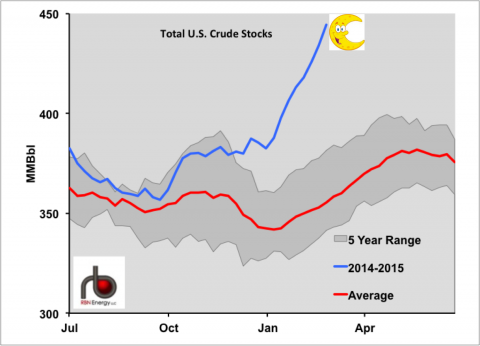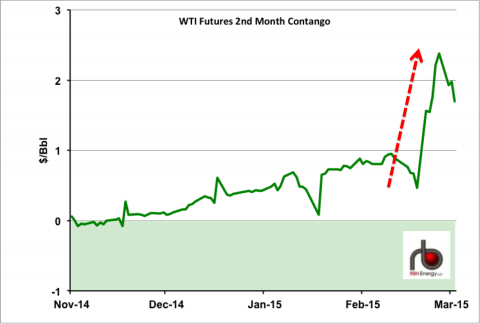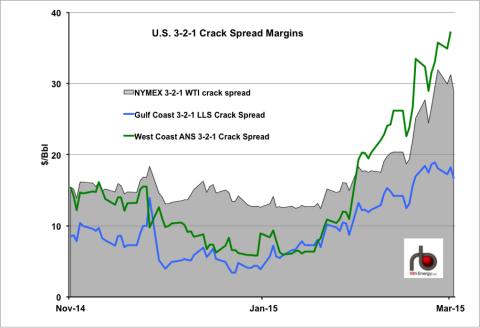From RBN Energy:
U.S. crude stocks are at their highest level in over 30 years and the contango market pricing structure continues to encourage increases in the stockpile. No one knows exactly how much storage space remains. The surplus is keeping U.S. crude prices low compared to international rivals but petroleum product prices (gasoline and diesel) are climbing higher, having bounced back from recent lows. Refining margins are sky high as bad weather and outages hamper operations. But as we describe today, the crude surplus remains a dark cloud on the horizon.
According to the Energy Information Administration (EIA) the nation is officially awash with crude supplies – stocks are up by 62 MMBbl since January 1st 2015 to 444 MMBbl at the end of February – highest ever (since EIA started the tally in 1982 – 33 years ago). About 10 MMBbl of crude was added to inventory between February 20, 2015 and February 27, 2015. The chart in Figure #1 shows total U.S. crude stocks since July 2014 (blue line – flying towards the moon) as well as the 5-year average (red line) and the 5-year range (darker gray area). The chart shows current levels 25% above the 5-year average and well outside the normal range for this time of year. About half of the inventory is located in the Gulf Coast region (220 MMBbl) and another 33 percent in the Midwest – the two principal refining regions. Depending on the amount of crude that U.S. refineries process (it varied seasonally between 15 and 16 MMb/d last year) current crude stocks are enough to supply refineries for between 27 and 30 days – about a month. All of these “commercial” supplies are on top of the 690 MMBbl Federally mandated Strategic Petroleum Reserve (see Save It For A Rainy Day).
Figure #1 – Source: RBN Energy, EIA data from Morningstar (Click to Enlarge)
There is absolutely no sign of a let up in the inventory build – with the only constraint appearing to be storage space to squirrel away more barrels. According to an EIA “Today In Energy” analysis last week, U.S. crude inventory took up about 60% of available capacity by February 20, 2015 and based on their reckoning have increased another 2% in the week following. The truth is that no one knows how much storage is really available. We do know that as storage gets harder to find, the cost of leasing it will continue to go up. Those increased storage costs will have an impact on crude market contango. As we explained recently contango occurs when prices for future delivery are higher than prices today (see Skipping The Crude Contango). If the contango spread is wide enough to cover the cost of leasing storage space, then traders can lock in a profit by putting crude into storage today and selling futures contracts for delivery at higher prices.
The current crude market contango spread is driven by the surplus of crude supplies weighing down prices for immediate delivery. Market theory says that as long as the surplus remains, today’s crude prices will be discounted to a level that covers the cost of storage since marginal buyers don’t need crude today. It follows that price pressure widens the contango spread as storage gets more expensive. Whether the theory is correct or not, the contango has certainly grown wider recently. Figure #2, shows the spread between prices for CME NYMEX West Texas Intermediate (WTI) futures contracts for delivery two months out minus prices for one month out (green line) since last November. The spread has been in contango (when the green line is above zero) since mid-November (the opposite of contango is backwardation when forward prices are lower than today – the green shaded area). The red dashed arrow highlights the recent jump in contango to more than $2/Bbl.
Figure #2 Source: CME data from Morningstar (Click to Enlarge)
A contango market gives refiners an incentive to buy crude and store it at their own facilities for later processing – especially if they have available storage space at nominal cost. Given the current record inventory levels there is likely to be a lot of that kind of storage buying occurring. Some refinery storage of surplus barrels is also likely happening during the traditional spring refinery maintenance period (see Turnaround) and at plants disrupted by bad weather or the ongoing refinery strike. But in today’s market, refiners also have a growing incentive to process as much crude as they are able to because of booming refinery margins. At the same time as crude prices in the U.S. have remained under pressure because of the storage surplus, prices for refined products have recovered sharply from their lows in January. That combination of cheap crude and high product prices is pushing refinery margins sky high. We recently explained how well crack spreads have been performing at the Gulf Coast and in the Midwest (see Don’t Stop The Party) and the situation has only improved (from a refinery perspective) since then. Recall that crack spreads are a way to boil down complex refinery operating processes to provide a basic measure of profitability using benchmark crude and product price ratios (see The Bakken Buck Starts Here – Part IV). We have frequently used the most common crack spread ratio – the 3-2-1 to represent the operation of a refinery outputting twice as much gasoline as diesel (you can see a daily 3-2-1 crack spread in the Spotcheck section of the RBN website – Backstage Pass members can dig deeper into the data). The chart in Figure #3 shows 3-2-1 crack spreads for three market regions representative of the East, Gulf and West Coast refineries. We will look at each in turn.
Figure #3 Source: CME data from Morningstar (Click to Enlarge)
...MORE


